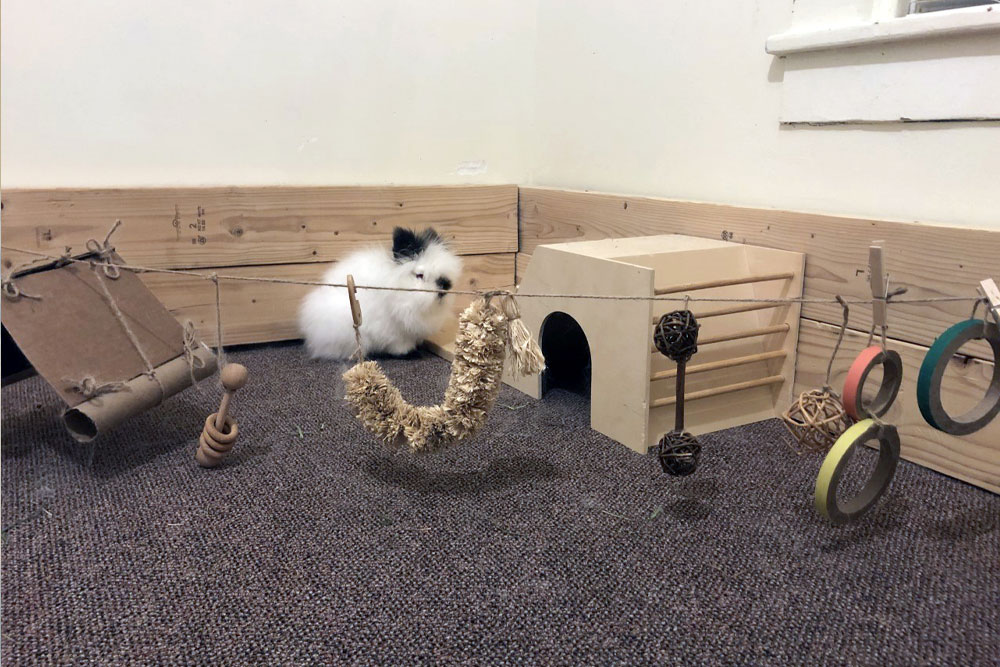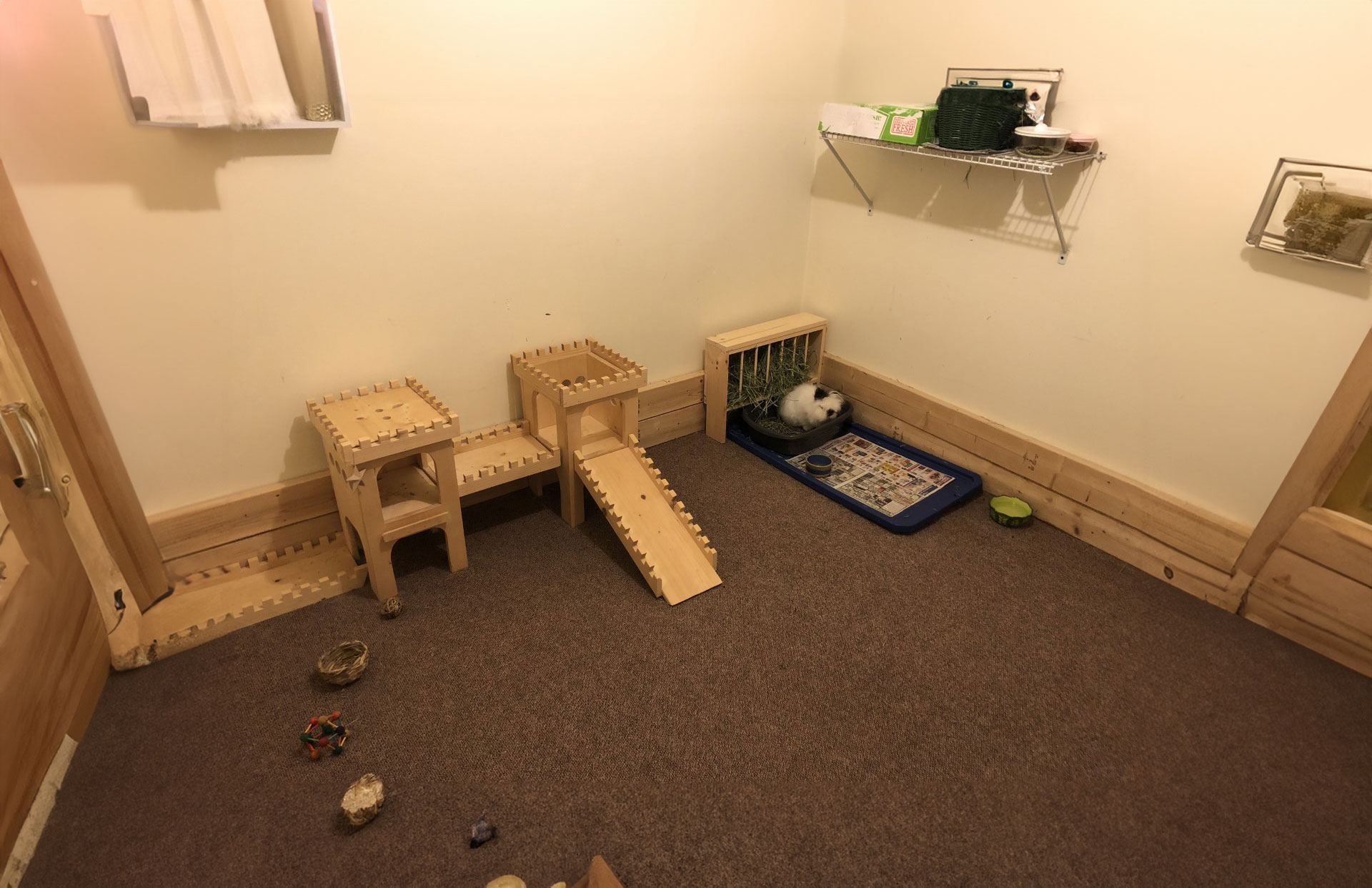As their human, I would do anything for my bunnies. This includes rabbit proofing anything remotely chewable … no matter how unattractive it may look to my friends and family. But just because something needs to be protected from a chew-happy bunny does not mean it has to be an ugly, bulky option; and I have learned sometimes all it takes is a good regimen of distraction techniques.
My intense interest in the safety of rabbit proofing started with my angel bunny, Bun Bun. Roughly five years ago, she climbed on top of her cardboard hut and decided to chew a good chunk of paint off the wall. I did not notice until she started having some health issues a few days later. A vet appointment was made, and lab work was drawn. It turned out she had significantly high lead levels in her blood stream that we assumed was from ingesting old lead-based paint that lay underneath years of new paint jobs. She was prescribed lead chelation medication that was given orally for a few weeks. The medicine binds with the lead in the bloodstream and is then able to be excreted. Bun Bun received this special medicine alongside gut motility medication and pain medication. She luckily recovered well after the medicine and had several follow-up appointments to reassess labs which did show a complete recovery.
After this incident where Bun Bun ate lead-based paint, I started seeing every potential hazard in the house and just had to think of a way to make it all safer—queue the beginning of my sacred rabbit room. Luckily, I had an extra bedroom that I turned into a rabbit safe sanctuary for my bunny to run around in freely. Of course, a designated rabbit space can be made anywhere using plexiglass, x-pen panels, buildable rabbit pens, or cardboard as long as the rabbit does not ingest too much of it.
Wanting to make it as rabbit proof as possible, I used untreated pine* boards as a baseboard all along the walls, making it high enough so a standing rabbit could not reach above the board. This serves three purposes: it protects the walls, it protects the edges of the carpet where my rabbit tends to dig, and it gives her a safe chew toy. I also built a gate from untreated pine boards to keep the area open and inviting but also safe. I made sure it is roughly three feet high to prevent an escape artist from venturing out. The fabulous castle built by her human grandpa hides the outlets that were cut out of the pine baseboards. I use the outlet behind the castle to plug an air conditioner into when summertime comes. The castle is large and immovable to my rabbit so it perfectly covers any cords that may entice some nibbles.
If affordable, having a web camera is a great way to stay vigilant and keep an eye on his or her every hop (like an eagle-eye predator!). Currently only my 4-year-old lion head, Lily, lives in my designated bunny room. I make sure to spend time with her daily; I usually sit on the floor and she will come over to chin my fingers or toes, and we appreciate being in each other’s company. Lily is truly queen of the castle.
*Pine is safe for bunnies as long as it is in whole form and untreated. Pine shavings are not recommended as rabbit litter due to the release of fragrance during the shaving process which can cause respiratory issues on their fragile systems.
So fast forward to when I adopted Hagrid, a 2-year-old rabbit. He started out in an x-pen, with an ultimate goal of being bonded with Lily. Hagrid ended up doing so well with a litter box, we tried free roaming and have never looked back. He has free roam of the whole upstairs and boy, does he take advantage of it. But this also made me nervous for all the cords, wires, corners, and whatever else a bunny finds chewable.
To start making the whole upstairs rabbit proof, I purchased a DIY rabbit pen where I could customize the size, shape, and length of the wire grids. I made sure to purchase fencing that didn’t have large squares because bunnies could easily get their heads stuck in that style of a pen. I created a long fence of wire grids to cover the length of wiring that runs underneath the bed, which happens to be Hagrid’s favorite spot.
I also shove wires through paper towel rolls to add a layer of protection. Those cords and wires just seem SO delicious to a rabbit, despite how dangerous it can be! Luckily, Hagrid does not chew the underside of the mattress; our bedframe is a grid pattern so it isn’t easily reached by his mouth. If he does start this behavior, I would then place a layer of flat cardboard underneath the mattress to make it safe.
Hagrid truly is an easily distracted rabbit so I make sure there is a hideout and a plethora of toys in each room that he has access to, along with a large dig box that he can forage around in. I make a point to sit on the ground and spend time with him every day by playing with stackable baby cups or tossing a rabbit toy near him to get him to interact. This makes for a less bored bunny which can play a role in his behavior and the chewing of non-safe items. Spending time with him every day also makes our bond stronger and brings so much happiness to my life and to his. I think we both enjoy laying on the floor together, playing with willow balls and wooden toys, and just being in each other’s company.
Rabbit proofing an area can seem tedious, but it is so worth it for the safety of your bunny and for the protection from potential destruction that a little bunny can cause. If you look at rabbit proofing as an art form, you may just find yourself becoming the new ‘Rabbit’ van Gogh.

Tips to Rabbit-Proof Your Space
- Cover chewable wires with cord protectors or paper towel tubes.
- Use buildable rabbit pen grids to build shapes to go around couches, tables, dressers, etc.
- Untreated pine wood makes an excellent and inexpensive chewable baseboard.
- Move toys, boxes, and shelters to places that tend to be of chewing-interest to your rabbit.
- A bored rabbit will find something to destroy … make sure there are plenty of interactive toys for them to play with!
- Spend time and play with your bunny! It helps with curbing their boredom and helps you bond with them too.
- Have a dig box accessible to your rabbit—make one with a cardboard box, shredded newspaper and hay, and then sprinkle pellets, herbs, or a few treats throughout the box.
- Seagrass mats are great spot coverings for places that a rabbit sees as chew-worthy.
Reviewed by HRS staff
Author: Gabrielle RogusPhoto Credit: Gabrielle Rogus
Journal Issue: House Rabbit Journal, Summer 2021




